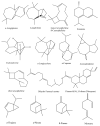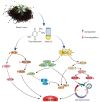Black Cumin (Nigella sativa L.): A Comprehensive Review on Phytochemistry, Health Benefits, Molecular Pharmacology, and Safety
- PMID: 34073784
- PMCID: PMC8225153
- DOI: 10.3390/nu13061784
Black Cumin (Nigella sativa L.): A Comprehensive Review on Phytochemistry, Health Benefits, Molecular Pharmacology, and Safety
Abstract
Mounting evidence support the potential benefits of functional foods or nutraceuticals for human health and diseases. Black cumin (Nigella sativa L.), a highly valued nutraceutical herb with a wide array of health benefits, has attracted growing interest from health-conscious individuals, the scientific community, and pharmaceutical industries. The pleiotropic pharmacological effects of black cumin, and its main bioactive component thymoquinone (TQ), have been manifested by their ability to attenuate oxidative stress and inflammation, and to promote immunity, cell survival, and energy metabolism, which underlie diverse health benefits, including protection against metabolic, cardiovascular, digestive, hepatic, renal, respiratory, reproductive, and neurological disorders, cancer, and so on. Furthermore, black cumin acts as an antidote, mitigating various toxicities and drug-induced side effects. Despite significant advances in pharmacological benefits, this miracle herb and its active components are still far from their clinical application. This review begins with highlighting the research trends in black cumin and revisiting phytochemical profiles. Subsequently, pharmacological attributes and health benefits of black cumin and TQ are critically reviewed. We overview molecular pharmacology to gain insight into the underlying mechanism of health benefits. Issues related to pharmacokinetic herb-drug interactions, drug delivery, and safety are also addressed. Identifying knowledge gaps, our current effort will direct future research to advance potential applications of black cumin and TQ in health and diseases.
Keywords: black seed; essential oil; molecular mechanism; nutraceutical; thymoquinone.
Conflict of interest statement
The authors declare no conflict of interest.
Figures












References
-
- Embuscado M.E. Spices and herbs: Natural sources of antioxidants—A mini review. J. Funct. Foods. 2015;18:811–819. doi: 10.1016/j.jff.2015.03.005. - DOI
-
- Chaudhry Z., Khera R.A., Hanif M.A., Ayub M.A., Sumrra S.H. Chapter 13—Cumin. In: Hanif M.A., Nawaz H., Khan M.M., Byrne H.J., editors. Medicinal Plants of South Asia. Elsevier; Amsterdam, The Netherlands: 2020. pp. 165–178. - DOI
Publication types
MeSH terms
Substances
Grants and funding
LinkOut - more resources
Full Text Sources

